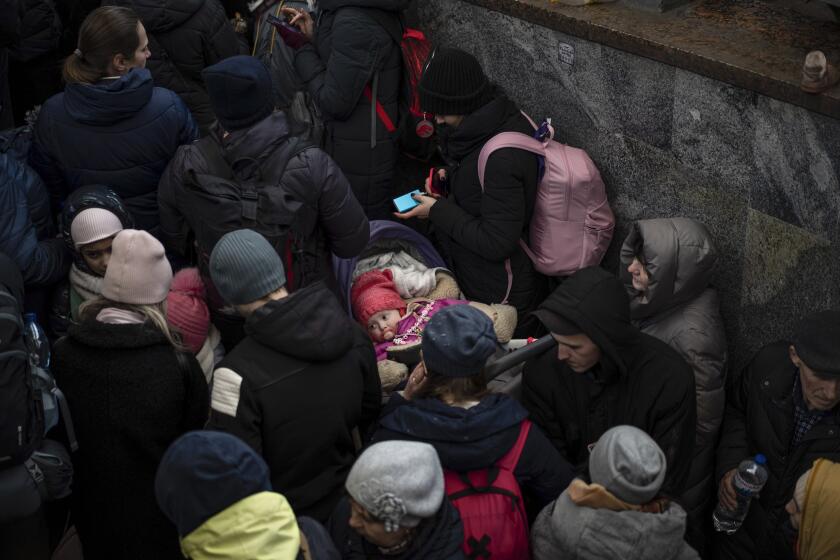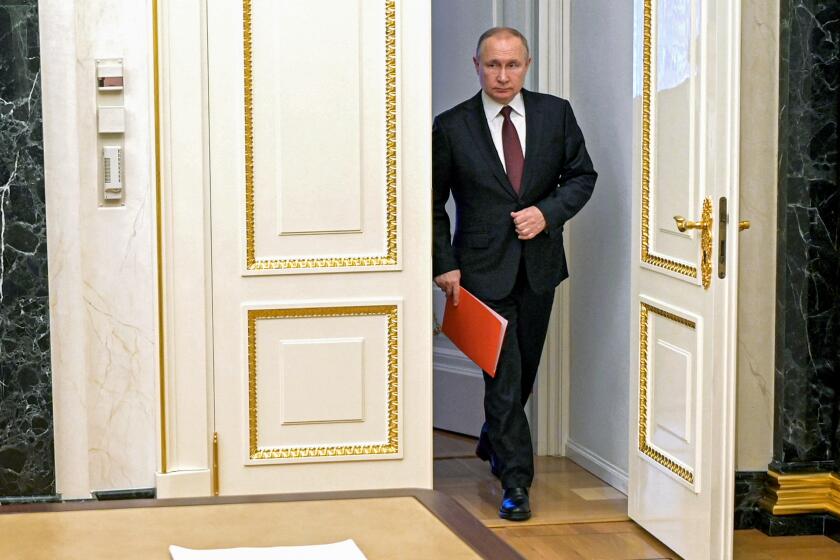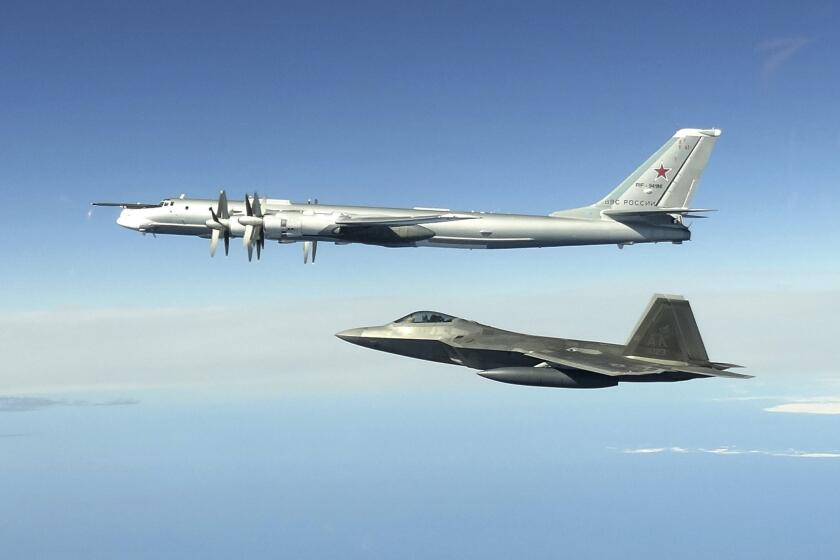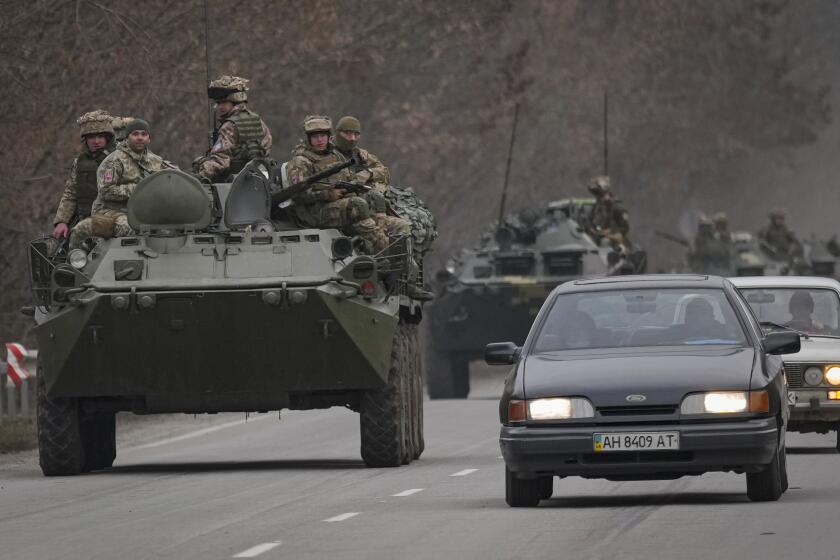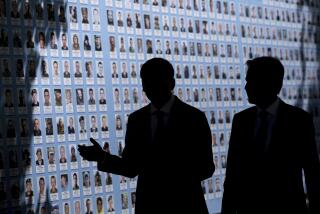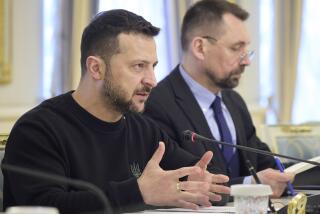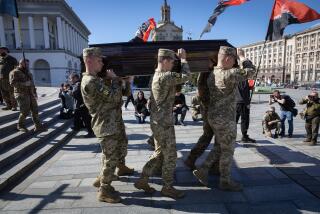Huge Russian convoy advances on Kyiv; missiles batter Ukraine, nearly 700,000 have fled
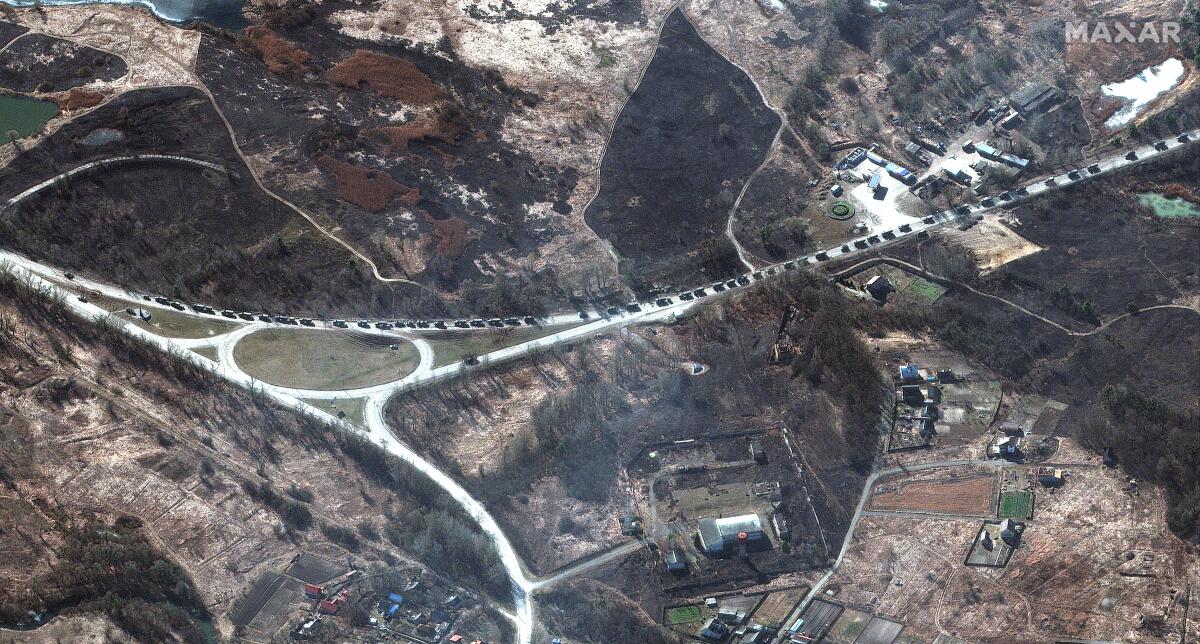
- Share via
KYIV, Ukraine — Russian forces struck government buildings, a television tower and Ukraine’s main Holocaust memorial on Tuesday as they ramped up their assault on urban centers and assembled a 40-mile-long column of tanks, artillery and other military vehicles outside Kyiv in what appeared to foreshadow an imminent assault on the capital.
The specter of more violence and the scenes of civilians huddled in bomb shelters or pouring across Ukraine’s western borders came as Russia found itself increasingly isolated on the world stage, with few allies beyond China and North Korea and sanctions inflicting immediate damage to its economy and currency.
For the record:
2:57 a.m. March 3, 2022An earlier version of this report incorrectly stated that the TV tower in Kyiv had been felled. It was disabled, but remains standing.
President Biden announced during his State of the Union address Tuesday night a ban on Russian aircraft in American airspace, the latest in a barrage of punitive measures that Biden said have made Putin “more isolated from the world than he’s ever been.”
Framing the Ukrainian war as part of a global “battle between autocracies and democracies,” Biden said Russia had “badly miscalculated.”
“When the history of this era is written, Putin’s war on Ukraine will have left Russia weaker and the rest of the world stronger,” he said.
The United Nations high commissioner for refugees, Filippo Grandi, said in a news briefing from Geneva that about 677,000 people had fled Ukraine in the last six days. The rate put the situation on track to “become Europe’s largest refugee crisis this century,” agency spokesperson Shabia Mantoo said in Geneva.
Russia stepped up its attacks on nonmilitary targets, with its Defense Ministry warning it would strike facilities of Ukraine’s Security Service along with communications centers “in order to suppress information attacks on Moscow.”
Soon after, a large explosion rocked Kyiv when Russian bombs disabled the capital’s landmark TV tower. Ukrainian defense officials said at least five people were killed and five others injured and TV programming was temporarily disrupted. The officials also reported a “powerful missile attack” near the Babyn Yar Holocaust memorial, which marks the site where nearly 34,000 Jews were killed within 48 hours in 1941 when the city was under Nazi occupation.
In Kharkiv, the nation’s second-largest city, a missile slammed into a central city square in front of a large government building, the Ukrainian Interior Ministry said. Video of the explosion outside the ornate building was shared widely on social media, showing cars driving through the cobblestoned square in the morning hours after the curfew’s break before being engulfed in flames.
Ukraine’s State Emergency Service said 10 people were killed and 24 wounded in the strike on Freedom Square, the site of Kharkiv’s regional government headquarters. An opera house and concert hall nearby were also hit.
The blast came after a barrage of what observers say might have been cluster bombs on a residential neighborhood Monday evening, killing at least nine civilians and wounding dozens of others in Kharkiv, a city of 1.4 million in northeastern Ukraine. President Volodymyr Zelensky condemned the attack as “state terrorism.”
Ukrainian authorities also confirmed reports that about 70 soldiers were killed in a Russian attack on a military base in the town of Okhtyrka, west of Kharkiv, on Sunday. And several people were wounded in strikes Tuesday on the southeastern port city of Mariupol, the Associated Press reported.
In an interview with Ukrainian 24 News, Mariupol Mayor Vadym Boychenko said, “Russian Nazis seek the genocide of the Ukrainian nation.”
“We will fight until the last bullet,” he said. “If they run out, we will use our teeth against the enemy that is moving toward Mariupol.”
Some 500,000 Ukrainians have fled their homeland since Russia invaded last week.
The bombardments hinted at a new, more violent phase in a Russian incursion that appeared to have partly stalled in the face of dogged resistance and possible logistical problems, such as a shortage of food and fuel.
A senior Pentagon official said Tuesday that there were signs Russian troops might be losing morale and that some had surrendered without a fight.
“They’re not only running out of gas, but they are running out of food,” said the official, who spoke on condition of anonymity. Yet Russia has been unrelenting in its bombardments, with the official saying more than 400 Russian-launched missiles had struck Ukraine as of Tuesday.
The U.N.’s Human Rights office said that since hostilities began Feb. 24 and up to midnight March 1, there had been 536 casualties, including 136 civilians killed — 13 of them children.
The toll’s rise matches alarm over fears of increased airstrikes and suspicions that Russian President Vladimir Putin will order his troops to encircle and blockade major population centers such as Kyiv and Kharkiv, bombing or starving them into submission.
Despite word from Russian officials quoted by the state news operator Tass that negotiations with Ukraine would resume Wednesday, Russian Defense Minister Sergei Shoigu said in a news conference Tuesday that the special military operation — Moscow’s term for its war in Ukraine — “will continue ... until the set goals are achieved.”
“What we see now see is a new wave of attack against Ukraine, against innocent people,” North Atlantic Treaty Organization Secretary General Jens Stoltenberg said at a news conference in Estonia on Tuesday. “And a column of heavy Russian armor which is moving towards Kyiv will bring more death, more suffering and more civilian casualties.”
Speaking virtually at the opening session of this year’s U.N. Human Rights Council meeting in Geneva on Tuesday, U.S. Secretary of State Antony J. Blinken blasted Moscow for its “mounting” human rights abuse and violation of international law.
“Russian strikes are hitting schools, hospitals and residential buildings,” Blinken said. “They are destroying critical infrastructure, which provides millions of people across Ukraine with drinking water, gas to keep them from freezing to death and electricity. Civilian buses, cars and even ambulances have been shelled.”
Later at Monday’s U.N. meeting, Russian Foreign Minister Sergei Lavrov spoke, also via videoconference. With delegates from Western countries turning their backs and staging a walkout, he launched into an angry speech justifying his nation’s invasion of Ukraine, accusing the neighboring former Soviet republic of atrocities against ethnic Russians in eastern Ukraine. And he claimed, with no evidence, that Kyiv was trying to secure nuclear weaponry.
The German representative, Katharina Stasch, accused Lavrov of a “cynical distortion of the facts,” according to the German news agency DPA.
Lavrov had planned to attend the meeting in person — but couldn’t travel because most of Europe has closed its airspace to Russian aircraft, as part of a battery of sanctions the West and others have imposed to punish Moscow.
Talks on Monday between Ukraine and Russia failed to bring the cease-fire that Kyiv demanded. More negotiations are in the offing, but Zelensky has expressed skepticism of any breakthrough, saying he agreed to talks only to show that he was shunning no opportunity to try to restore peace.
As the invasion stretched into its sixth day, residents of Kyiv braved freezing temperatures and trudged through snow Tuesday to line up outside supermarkets, gas stations and even the small coffee kiosks that dot the sidewalks here to stock up before a Russian assault.
Episodes of peculiar behavior by Russia’s leader have marked the time frame surrounding the Ukraine assault. But what’s behind them?
Throughout the capital there were signs of a city hunkering down. Makeshift checkpoints sprang up overnight in greater numbers than before. Reservists dressed in civilian clothing — some of them young men who appeared to be barely out of high school — wrapped yellow armbands around their sleeves, indicating they were with the so-called Territorial Defense Force, a sort of people’s army that has joined regular troops in repulsing a Russian blitz. Wielding guns, they manned hastily assembled barriers of tires, trash bins and other detritus and stopped motorists to check their cars.
To the northwest of the city, closer to Russian positions, traffic was almost nonexistent; even the large neighborhood supermarket had no lines. Soldiers shooed away anyone approaching, warning them that Russian artillery fire had started up.
Moments later, a blast hit nearby, reverberating across the tall birch forests on the side of the highway.
Vadym Prystaiko, Ukraine’s ambassador to the U.K., told British lawmakers that Ukrainian troops still maintained control of the western approach to Kyiv and the western part of the country, which is vital to keep the capital from being strangled by Russian forces. He said Ukraine’s military had 200 tanks and 700 trucks to help defend the country and keep supply routes open.
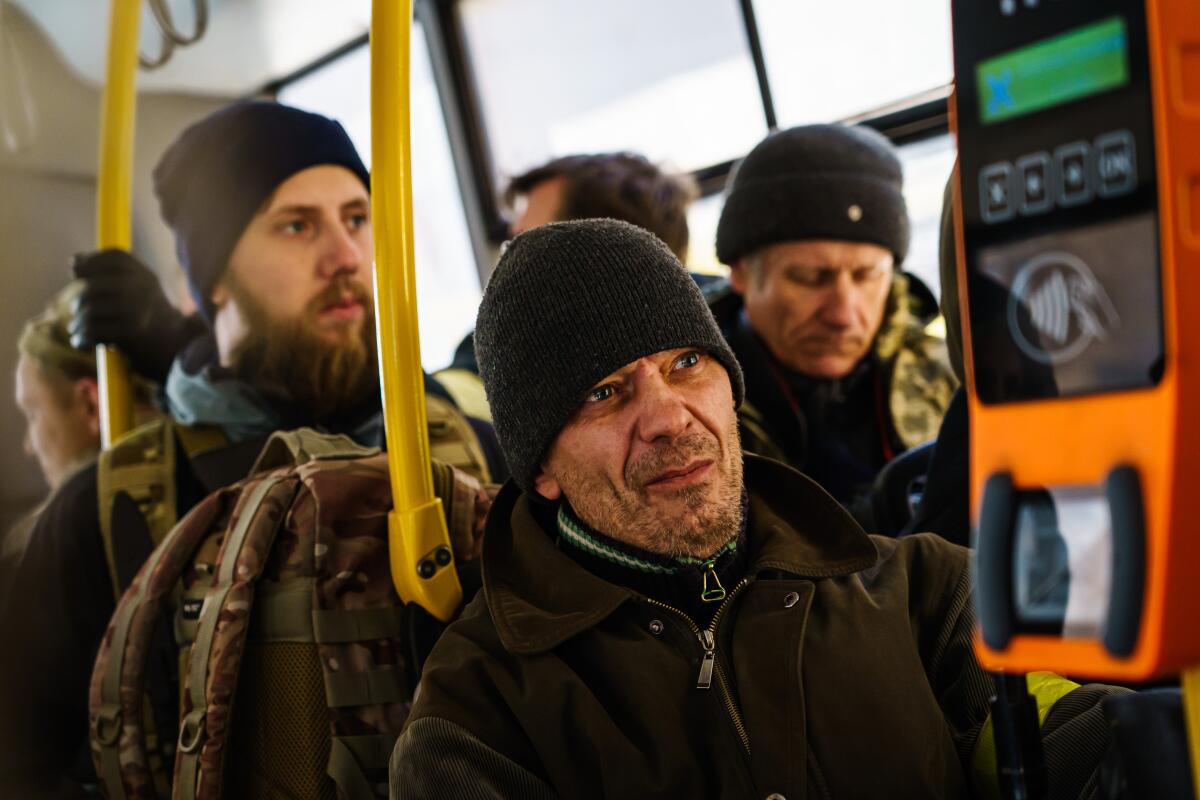
But the massive convoy of Russian armored vehicles to the north of Kyiv, which satellite images showed stretching for 40 miles, augured a major assault.
On Tuesday afternoon, the Russian Defense Ministry issued a warning, carried by Tass, that its forces would be launching “high-precision weapons” at a facility belonging to the Security Service of Ukraine and an information and psychological operations center in Kyiv “in order to suppress information attacks against Russia.” The statement warned residents in the area to leave their homes.
“They want to break our nationhood — that’s why the capital is constantly under threat,” Zelensky said in a video address late Monday, adding that Kyiv was hit by three missile strikes Monday and that hundreds of Russian saboteurs were roaming the city.
Many, including remaining staff and family members of foreign embassies, decided that threat was too high. Thousands carrying what bits of their life they could take massed in Kyiv’s train station, lugging suitcases on stairs while others stared at the departures board, almost willing it to change. It showed that the train from Kharkiv had arrived; there was no return trip.
Outside, near a commercial center, an advertising billboard shuffled through messages directed at the coming Russian troops, telling them, “Instead of flowers, bullets are waiting for you” or “How can you look in the eyes of your children?” Others were more direct: “Russian soldier, go f— yourself.”
A host of Western nations, including most recently Australia, have agreed to supply Ukraine with military aid. But they have rebuffed calls to impose a NATO-led no-fly zone over Ukraine because of the risk of starting a much larger war.
Breaking News
Get breaking news, investigations, analysis and more signature journalism from the Los Angeles Times in your inbox.
You may occasionally receive promotional content from the Los Angeles Times.
“Unfortunately the implication of that is that the U.K.” — and other nations — “would be engaged in shooting down Russian planes,” British Prime Minister Boris Johnson said in Warsaw. “It would be engaged in direct combat with Russia. That’s not something that we can do or that we’ve envisaged. ... The consequences of that would be truly very, very difficult.”
Kyiv and Kharkiv, as Ukraine’s two most populous cities, hold enormous symbolic significance and are therefore prime targets, said Prystaiko, the ambassador, pointing to the historical example of the Bolshevik Revolution in Russia more than a century ago.
“They are using the same textbook they used from 1918 when they couldn’t take Kyiv,” Prystaiko said. “They took Kharkiv” and proclaimed the Ukrainian People’s Republic, with Kharkiv as its capital. Then, “as soon as Kyiv fell, they moved the capital back to Kyiv. So I believe that that’s one of the scenarios” now.
Putin puts nuclear forces on high alert, but is there reason to worry?
Johnson, after a meeting with the Polish premier, said that the West was prepared to intensify its sanctions on Moscow for “unfolding disaster in our European Continent.”
“I say to Vladimir Putin and his regime: There is only one way out of this morass, and that is to stop the tanks, to turn back the tanks, on their way to Kyiv — turn them round and take the path to peace,” Johnson said.
Russian tanks and troops crossed into Ukraine on Thursday after a night of shelling. But why is Russia attacking Ukraine? What is Putin’s goal?
On Monday, Zelensky said he had officially signed an application for Ukraine’s membership in the European Union.
In a video address to the European Parliament early Tuesday afternoon, he passionately called for Ukraine to be let into the 27-nation club, although accession is a distant prospect.
“We are fighting also to be equal members of Europe,” Zelensky said. “I believe that today we are showing everybody that is what we are. ... We have proven that, at a minimum, we are the same as you.”
At night in Kyiv, with curfew back in place, the explosions were more sporadic. Air raid sirens wailed. When they stopped, all that remained were the slap of ropes against flagpoles and the subdued whir of a sidewalk billboard shuffling through its posters — for a bank and a rock concert from last week. Above, the streetlights stayed on, illuminating the streets for no one.
Bulos reported from Kyiv, Linthicum from Mexico City and Wilkinson from Washington. Times staff writers Anumita Kaur in Washington and David Pierson in Singapore contributed to this report.
More to Read
Sign up for Essential California
The most important California stories and recommendations in your inbox every morning.
You may occasionally receive promotional content from the Los Angeles Times.
